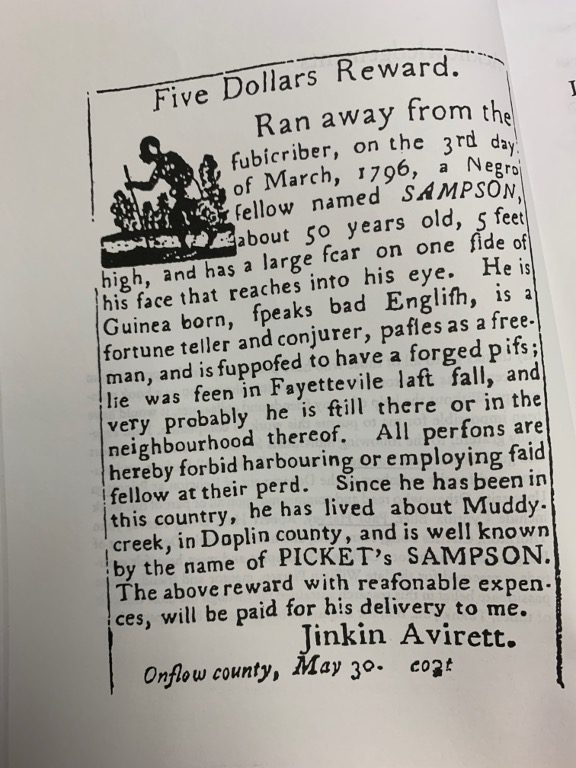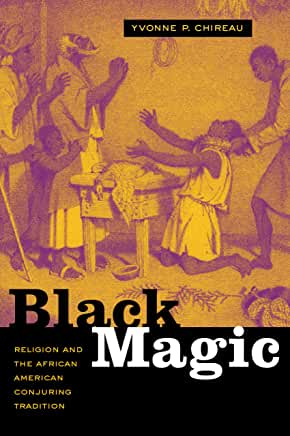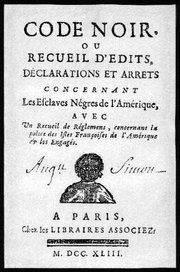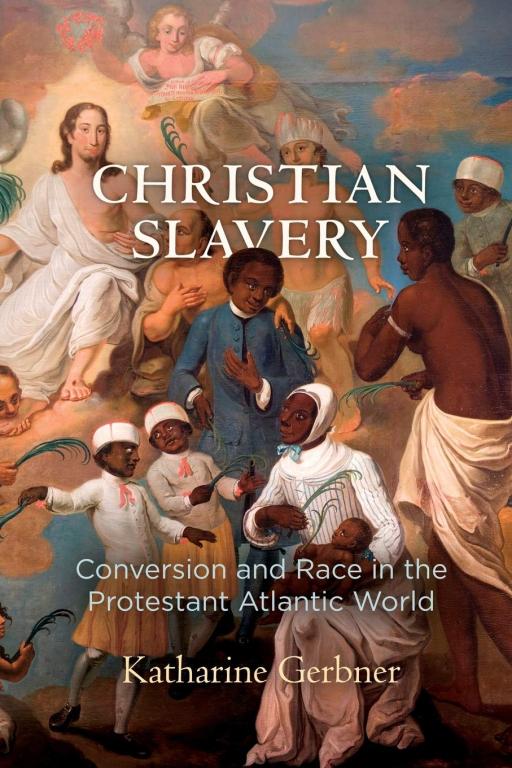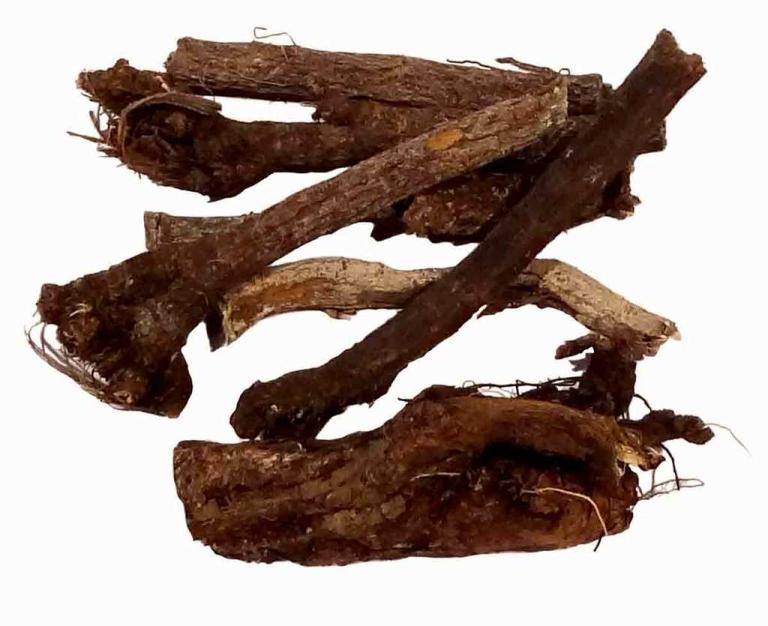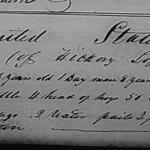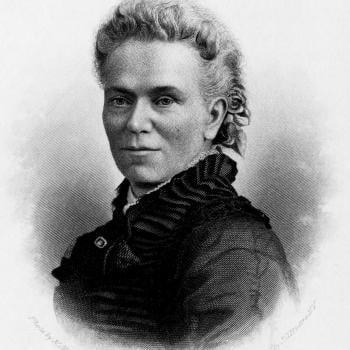In Hall’s Wilmington Gazette newspaper issue of October 1798, Jinkin Avirett posted an advertisement for his runaway slave, Sampson. Avirett described Sampson as disfigured with a scar and walking with a staff. What sets Sampson apart was that he practiced the magical art of conjure and told fortunes. Sampson’s inclination towards magic was more common among the enslaved than many assume.
People who are oppressed look for ways to liberate themselves, even if liberation is not whole or complete. They seek ways to alleviate the anxiety, pain, and trauma of their current conditions. Enslaved people in the British colonies, such as the runaway slave Sampson, conjured their own liberation through the means of magic and witchcraft. They turned to this means of liberation because their White, Christian, British oppressors suppressed their reception of Christianity.
It is commonly understood that British colonial plantation masters suppressed enslaved Africans and their African-American scions from embracing Christianity. Yvonne Chireau’s outstanding account of magic among African-Americans, Black Magic: Religion and the African American Conjuring Tradition, asserts that White suppression of Christianity among the enslaved continued into the nineteenth century:
Slaveholder’s hostility, linguistic barriers, financial constraints, and the cultural intransigence of Africans themselves greatly hindered the progress of Christian missionaries who attempted to convert the enslaved in the colonial era…Only after the turn of the nineteenth century did any widespread, self-perpetuating evangelical activity take place among black slaves (42).
While the 1685 Code Noir of Louis XIV set precedents in the New World for slave laws and made provisions for deterring the use of magic and the inculcation of Roman Catholicism in the French imperial sphere, codification of slave laws in the British colonies differed remarkably from French laws.
As a result, plantation culture in the British colonies facilitated an affinity for the enslaved to practice contraband forms of magic, which competed with contraband practices of Christianity. While generalizations are rarely accurate and documentary evidence demonstrates that plantation masters varied in what practices they sanctioned among their enslaved, an intriguing feature of plantation life in the British Colonial South was that some masters had an affinity to affirm the practice of conjure, while trenchantly prohibiting Christian practices. It really depended upon the master’s view of magic and piety. The more pious a master was, the less likely he permitted magical practices. Pious British colonial masters eschewed witchcraft because Christian ministers inculcated a malefic conception of magic. Practices of magic, witchcraft, or conjure were harmful, demonic, and evil. They were a threat to Christians and Christianity. Fundamentally, the British colonies racialized Christianity and conjure. Christianity was racially White. Conjure, magic, and witchcraft were racially Black, Brown, or Red.
In 1662, the Virginian colony passed a law that colonial children were born with the social status of their mother, partus sequitur ventrem, which was a reversal of English common law. Colonists justified this reversal by arguing that blacks were not Christian, thus, English law does not apply.
The Virginian Slave Code of 1705 put punitive measures in place against parish ministers for officiating mixed-marriages between whites and blacks. In order to discourage racial mixation, ministers were punished with a fine of 10,000 pounds of tobacco for performing an interracial marriage. This same slave code empowered parish vestries to dispossess blacks of their livestock or goods for the sake of providing charity for poor whites within the parish. In this slave code, the term Christian is contrasted and put in opposition with ethnic descriptions of those who are “negro, mulatto, or Indian, Jew, Moor, Mohametan, or other infidel” (Virginia Slave Code of 1705, 450). If any of these ethnic identities attempted to “purchase any Christian white servants,” the Virginian Slave Code of 1705 circumvented white Christian enslavement (Virginia Slave Code of 1705, 450). A careful reading of this slave code indicates that British citizenship assumed whiteness and Christianity.
Katharine Gerbner called this phenomenon the Christian supremacy that led to White supremacy. She identified how the notion of whiteness first appeared in Barbados slave laws in 1662 and White Supremacy became codified on this island in 1697. In her work, Christian Slavery, she argues: “By the early eighteenth century, then, whiteness had been reified into a potent social and political category on Barbados, replacing Christianity as the most salient axis of difference” (87).
Progressively across the eighteenth century, additional laws suppressed the spread of Christianity among the enslaved in the British colonies. For instance, following the Stono rebellion in Carolina, the Negro Act of 1740 suppressed slaves by making it illegal for them to assemble in meetings, learn to write, or earn money.
The southern colonies of Chesapeake and Carolina employed militia to patrol the land and capture marooned slaves, suppress slave assemblies, and search slave quarters for contraband possessions. White militia suppressed slave rebellion and functioned as an intimidating force for the slave population, the function of the militia, as a deterrent of rebellion and an apparatus of intimidation, became integral to the security of the southern colonies, especially as the ratio of slave to white population altered. By 1730, the Province of Carolina had a 1 to 2 ratio of white people to enslaved black people. By 1750, 40% of the population in the Chesapeake were enslaved.
When depicting the distinction between chattel slavery in the British colonies from slavery in the Grecco-Roman world or enslavement taking place contemporaneously in the Muslim world or Africa, there are at least eight observable features that distinguish and depict chattel slavery from other expressions of slavery.
In chattel slavery…
- The human agency of an enslaved person is denied by treating that person as personal property, who cannot possess personal property.
- The enslaved person exists in involuntary, coercive, and perpetual servitude to a master.
- The location and ownership of an enslaved person is controlled by a master.
- The enslaved person is used sexually in whatever way the master wishes.
- The enslaved person is bought and sold at the master’s will.
- The enslaved person is outsourced as a labor wage for the master.
- The enslaved person’s family structure is unrecognized.
- The enslaved person endures violent, coercive punishment: whipping, beating, burning, mutilation, branding, imprisonment, shackling—in order to maximize their labor output.
Since Christianity was suppressed among the enslaved, slaves had to seek alternative ways to secure liberation. Witchcraft and magic offered a viable apparatus for liberation from each of the above features of oppression within the system of British colonial chattel slavery. Furthermore, the use of magical charms and amulets, referred to as fetishes, in the Caribbean and southern British colonies, empowered the enslaved to mimic the control and power their masters possessed. Chattel slaves of British masters employed magical and witchcraft practices in order to reverse their oppression and empower their liberation. Here are five ways that they did so.
Labor Liberation
First, masters possessed enslaved African-Americans and coerced them to do their work, while not allowing them to own possessions. African-American’s reversed this oppression by possessing magical amulets that did magical work for them. Also, African-American conjurors used their magical reputations to liberate themselves from everyday slave labor. As enslaved conjurors built their reputations, masters felt threatened by their magical powers. As a result, masters extended a latitude of labor freedom to these conjurors. In exchange, masters hoped their enslaved conjurors would refrain from using malefic magic against them. The enslaved also embedded the thresholds of their slave quarters with protective runes or markings, in order to intimidate militia from entering their quarters. Hopefully, these measures protected their contraband possessions from being discovered and confiscated by their masters.
Turning a Profit
Second, masters outsourced their slaves as labor in order to turn a profit for themselves. Likewise, enslaved conjurors sold contraband magical charms to their masters, masters’ household, staff, and fellow slaves in order to turn a profit. Furthermore, enslaved conjurors performed services for their masters for a fee: they offered healing services; they drove out haunting spirits; they told fortunes; and provided other services including the recovery of lost or stolen items. All for a fee.
Geographical Liberation
Third, masters controlled the location of their enslaved. At the master’s will, he could separate enslaved partners from one another or separate children from parents. Insubordinate slaves might be sold off to other plantations or into the other industries, like the sailing industry. By doing so, the master demonstrated his complete mastery over the slave’s geography.
Similarly, fetishes possessed animist spirits of the African tradition. Enslaved conjurors “imprisoned” spirits within the amulet and had territorial control over that spirit. Conjurors also developed reputations of having familiar spirits or having the power to transmorgrify themselves. A familiar spirit was an animal or spectral spirit that could evade the geographical boundaries set by the master and report to an enslaved witch about happenings beyond their geographical confinement. Transmorgrification was the power for a witch to transform into an animal. Once transformed, a witch could slyly slip outside the geographical boundaries of the plantation.
Protection from Punishment
Fourth, masters punished enslaved bodies and did harm to them through their coercive and violent abuse. Enslaved conjurors reversed this oppression by performing malefic (harmful) magic against their masters and family. They also wore apotropaic amulets that protected them from the harmful practices of their masters. Some amulets promised to make the wearer unseen by masters. Thus, the enslaved person could work in the field and be spared by the master’s whip. Possessing tree roots and concealing them on their person was one protective measure for an enslaved person to conceal themselves from their master’s eye.
Sexual Empowerment and Liberation
Fifth, masters could use their slaves sexually. They had the power to breed slaves, regardless of whether male and female slaves were covenant partners. Masters would also force themselves upon female slaves in order to produce more laborers. However, enslaved conjurors produced charms that protected female slaves from rape. They could also offer a charm to a male slave that made him especially virile and worthy to be the master’s pride breeder. For instance, a raccoon baculum (penis bone) was discovered during an archaeological dig at George Washinton’s Mount Vernon slave quarters. The presence of this bone, apart from the rest of the raccoon remains, and its location in the slave quarters, implies that it was worn as a fertility symbol. A small incision at one end of the bone, indicates that a line had been run through it, and it was worn around the neck (Elaine Breslaw, ed., Witches of the Atlantic World, 172).
Why would a slave wish to have this amulet? Well, successful breeders would be given extra freedoms, be spared from punishment, and enjoy a nutritional diet. Conjurors also provided potions that enabled users to control the affections of those who consumed the potion, which gave conjurors the same power to manipulate sex that their masters’ possessed.
One of the lamentable realities of the suppression of Christianity among enslaved populations in the British colonies is that suppression forced enslaved people to look for other outlets of liberation. The most readily available alternative to Christianity was magic and witchcraft. What made witchcraft so attractive to enslaved people in the British colonies is that it empowered and liberated them. Those in servitude could now possess the powers their masters’ possessed. They could wield magic to reverse roles and cause harm to their masters or earn a profit from them. They could liberate their bodies from work, geographical boundaries, or sexual manipulation.
The British colonies put forth a concerted effort to suppress Christianity among the enslaved. As a result, some enslaved turned to the practice of magic and witchcraft, which empowered and liberated them.
In light of this history, we might rightly ask the question today—what ideologies and alternative forms of empowerment and liberation might African-American, Latino/a, Asian, and Native citizens of the United States embrace, if they feel like Christianity is no longer a welcoming space for them because of White Christian Nationalism, woke prejudice, and anti-CRT initiatives?


